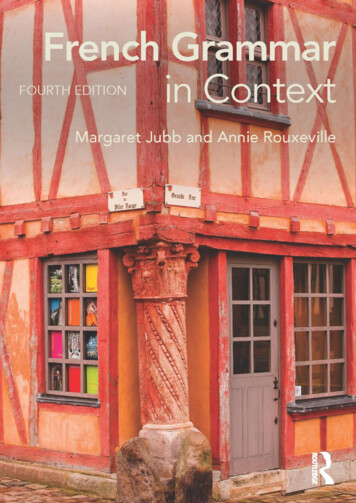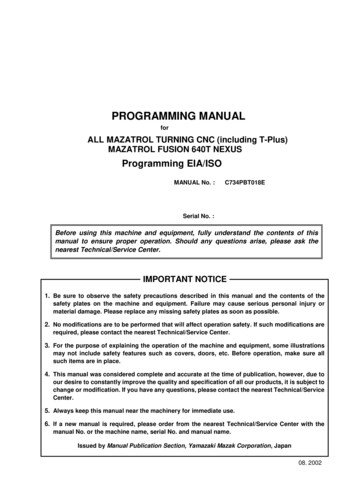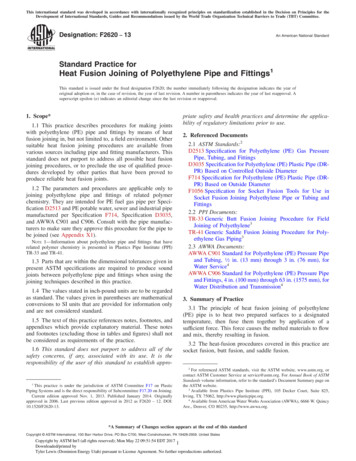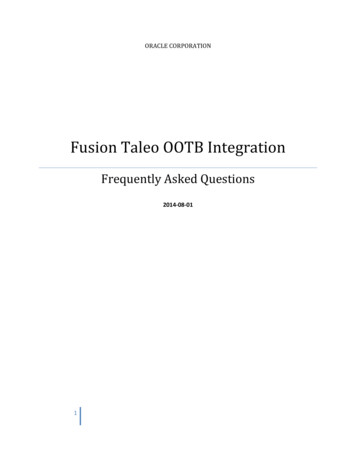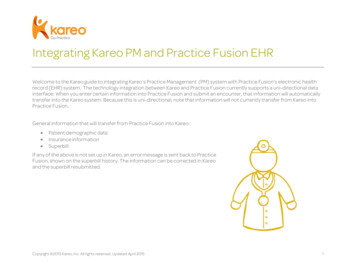
Transcription
Image Fusion for Context Enhancement and Video SurrealismRamesh Raskar Mitsubishi Electric Research Labs (MERL)†,Cambridge, USAAdrian IlieUNC Chapel Hill, USAJingyi YuMIT, Cambridge, USAFigure 1: Automatic context enhancement of a night time scene. The image is reconstructed from a gradient field. The gradient field is alinear blend of intensity gradients of the night time image and a corresponding day time image of the same scene.Abstractlumination. As a real life example, when you look at an image orvideo seen from a traffic camera posted on the web or shown on TV,it is very difficult to understand from which part of the town this image is taken, how many lanes the highway has or what buildings arenearby. All you see is pair of headlights moving on the screen (Fig2(a)). How can we improve this image? Our solution is based ona very simple observation. We can exploit the fact that, the trafficcamera can observe the scene all day long and create a high qualitybackground. Then, we can simply enhance the context of the lowquality image or video by fusing the appropriate pixels as shown inFigure 1(b) and 2(b) [Raskar et al. 2003b]. This idea appears to bevery simple in retrospect. However, despite our search efforts, thisconcept of image fusion appears to have been unexplored. The closest work we found of combining daytime and nighttime images ofthe same scene came from a rather unexpected source: a Surrealistpainting by René Magritte.Surrealism is the practice of producing incongruous imageryby means of unnatural juxtapositions and combinations [MerriamWebster 2001]. In the well-known surrealist painting by ReneMagritte’s , ’The Empire of Lights’, a dark, nocturnal street scene isset against a pastel-blue, light-drenched sky spotted with fluffy cumulus clouds, with no fantastic element other than the single paradoxical combination of day and night. Each part on its own looksreal, but it is the fusion of parts that gives a strange non-realisticappearance in the overall context (Figure 3). Inspired by this notion of adding unusual context, in this paper we present a class ofimage fusion techniques to automatically blend different images ofthe same scene into a seamless rendering. We are not artists andcomputer generated fusion is unlikely to evoke similar emotions.But we hope to provide digital tools for artists to create new typesof surrealist images as well as videos.We present a class of image fusion techniques to automaticallycombine images of a scene captured under different illumination.Beyond providing digital tools for artists for creating surrealist images and videos, the methods can also be used for practical applications. For example, the non-realistic appearance can be usedto enhance the context of nighttime traffic videos so that they areeasier to understand. The context is automatically captured froma fixed camera and inserted from a day-time image (of the samescene). Our approach is based on a gradient domain technique thatpreserves important local perceptual cues while avoiding traditionalproblems such as aliasing, ghosting and haloing. We presents several results in generating surrealistic videos and in increasing theinformation density of low quality nighttime videos.Keywords: image fusion, surrealism, gradient domain approach1 IntroductionNighttime images such as the one shown in Figure 1(a) are difficultto understand because they lack background context due to poor il raskar@merl.com, adyilie@cs.unc.edu, jingyi@graphics.csail.mit.edu† http://www.merl.com/projects/NPRfusion/Copyright 2004 by the Association for Computing Machinery, Inc.Permission to make digital or hard copies of part or all of this work for personal orclassroom use is granted without fee provided that copies are not made or distributedfor commercial advantage and that copies bear this notice and the full citation on thefirst page. Copyrights for components of this work owned by others than ACM must behonored. Abstracting with credit is permitted. To copy otherwise, to republish, to post onservers, or to redistribute to lists, requires prior specific permission and/or a fee.Request permissions from Permissions Dept, ACM Inc., fax 1 (212) 869-0481 or e-mailpermissions@acm.org. 2004 ACM 1-58113-887-3/04/0006 5.001.1OverviewOur image fusion approach is based on a gradient domain techniquethat preserves important local perceptual cues while avoiding tradi-85
Gradient domain methods Our approach is inspired by somerecent methods that work in the gradient space rather than intensityspace.Image conflation and fusion of multi-spectral imagery to mergesatellite imagery captured at different wavelengths is a commonapplication [Socolinsky and Wolff 1999]. The images are relatively similar and the output is not always rendered in a pseudophotorealistic manner.For compressing HDR images [Fattal et al. 2002] attenuate largeimage gradients before image reconstruction. However, our problem is different from combining high dynamic range images. InHDR images, the pixel intensities in successive images increasemonotonically allowing one to build a single floating point formatimage. This is not possible in our case. In day-night images wesee intensity gradient reversals (such as objects that are darker thantheir surroundings during the day, but brighter than their surroundings during the night).Pèrez et al. [Pèrez et al. 2003] present a useful interactive image editing technique that uses integration of modified gradients tosupport seamless pasting and cloning. However, since their goal isto provide a framework for image editing, they rely on user input tomanually assign the region from which the gradients are taken.Authors of [Finlayson et al. 2002] remove shadows in an imageby first computing its gradient, then distinguishing shadow edges,setting the gradient values at the shadow edges to zero and finallyreintegrating the image. [Weiss 2001] uses a similar method forcreating intrinsic images to reduce shadows.Figure 2: Enhanced traffic video. A low quality nighttime image,and a frame from the final output of our algorithm.tional problems such as aliasing, ghosting and haloing. We first encode the pixel importance based on local variance in input imagesor videos. Then, instead of a convex combination of pixel intensities, we use linear combination of the intensity gradients wherethe weights are scaled by the pixel importance. The image reconstructed from integration of the gradients achieves a smooth blendof the input images, and at the same time preserves their importantfeatures.1.2Related WorkFusion We can classify the methods to combine informationfrom multiple images into one by noting which parameter of thescene or the camera is changing between successive images. Themain idea can be traced to the 19th century by Marey and Murbridge [Muybridge 1985; Braun 1992], who created beautiful depictions of objects over time. Fusing images varying in depth include the classic depiction of motion and shape in Duchamps NudeDescending a Staircase. This has been extended by Freeman andZhang [2003] via a stereo camera. The automatic method is calledshapetime photography and also explored by [Essa 2002]. Imagescaptured by varying camera exposure parameters are used to generate high-dynamic range (HDR) images. Tone mapping for compression of such images includes gradient space [Fattal et al. 2002]and image space [Durand and Dorsey 2002; Reinhard et al. 2002]methods. Images captured with varying focus can also be combined to create all-in-focus imagery [Haeberli 1994]). Images withvarying camera viewpoint are combined in cubism, using multiplecenter-of-projection images [Rademacher and Bishop 1998] and byreflectance map of laser scanners. In this sense, our method can beconsidered as fusion of images varying in natural illumination.Novel images have been created via video cubes, i.e. by slicing3D volume of pixels, by [Fels and Mase 1999; Klein et al. 2002b;Cohen 2003]. We explore non-planar cuts in the cubes of spatiotemporal gradient fields of videos.Figure 3: The Empire of Light, by René Magritte (Used by permission, Guggenheim Museum, New York).Videos When stylization and non-photorealistic rendering(NPR) methods designed for static images are applied to video sequences on a frame-by-frame basis, the results generally containundesirable temporal artifacts. To overcome these artifacts, [Meier1996; Litwinowicz 1997; Hertzmann and Perlin 2000] used opticalflow information to maintain temporal coherency. We use a similarapproach in the gradient domain.Interesting spatial composition of multiple videos is created forart via video mosaics [Klein et al. 2002a] or for shot composition and overlay rules, based on ’region objects’ [Gleicher et al.2002] in the context of virtual videography of classroom teaching.Our method of achieving temporal coherency is related to the region objects which are defined by pixel neighborhoods in spaceand time. Sophisticated image and video matting methods [Chuanget al. 2001] are also useful for foreground segmentation.1.3ContributionsOur main contribution is the idea of exploiting information available from fixed cameras to create context-rich images. Our technical contributions include the following. A scheme for asymmetrically fusing multiple images preservinguseful features to improve the information density in a picture; A method for temporally-coherent context enhancementof videos in presence of unreliable frame differencing.In addition, we modify the method of image reconstruction fromgradients fields to handle the boundary conditions to overcome integration artifacts. We employ a color assignment strategy to re-86
duce the commonly known artifact of the gradient-based method–observable color shifting.A fused image should be “visually pleasing”, i.e., it should havevery few aliasing, ghosting or haloing artifacts and it should maintain smooth transition from background to foreground. Our methodachieves this by using the underlying properties of integration. Weshow how this can be used for synthetic as well as natural indoorand outdoor scenes.Our proposed algorithm consists of two major steps similar tovideo matting: foreground extraction and background fusion. Robust foreground extraction in image space is difficult to achieve inpractice, especially when dealing with low contrast and noisy images and videos. Therefore we propose a gradient space algorithm.A gradient space method also allows us to simply state the constraints on the resultant image i.e. which parts of constituent imagesshould be preserved. Then we search for an optimal image thatsatisfies gradient image in the least-square error sense. Comparedto gradient domain approaches described above, our approach attempts to fuse images that are sufficiently different. We are inspiredby many of the techniques mentioned above and aim to addresssome of their limitations. We support automatic region selection,allow linear blend of gradient fields and extend the technique tosupport video synthesis.image (a weighting function) W , by processing the gradient magnitude G . The weighted combination of input gradients gives usthe gradient of the desired output (Figure 4). The basic steps aredescribed in Algorithm 1.Algorithm 1 Basic algorithmfor each input image Ii doFind gradient field Gi IiCompute importance image Wi from Gi end forfor each pixel (x,y) doComputemixedgradientfieldG(x, y)PPWi (x, y)Gi (x, y)/ i Wi (x, y)iend forReconstruct image I 0 from gradient field GPNormalize pixel intensities in I 0 to closely match i Wi IiAs described in the following sections, the process of determining importance weights Wi , depends on the specific application.2.22 Image FusionImage ReconstructionImage reconstruction from gradients fields, an approximate invertibility problem, is still a very active research area. In 2D, a modifiedgradient vector field G may not be integrable. We use one of thedirect methods recently proposed [Fattal et al. 2002] to minimize I 0 G . The estimate of the desired intensity function I 0 , sothat G I 0 , can be obtained by solving the Poisson differentialequation 2 I 0 divG, involving a Laplace and a divergence operator. We use the full multigrid method [Press et al. 1992] to solvethe Laplace equation. We pad the images to square images of sizethe nearest power of two before applying the integration, and thencrop back the result to the original size.We present the basic algorithm for image fusion followed by ourapproach to ensure better image reconstruction and color assignment.2.1 Basic AlgorithmHow would one combine information from two (or more) images ina meaningful way? How would one pick high-quality backgroundparts from a daytime image while keeping all the low-quality important information from a nighttime image? The traditional approach is to use a linear combination of the input images. Weinstead specify the desired local attributes of the final image andsolve the inverse problem of obtaining a global solution that satisfies the local attributes. This leads to a non-linear combination,which means pixels with the same intensities map to different intensities in the final image. Our basic idea for determining the important areas of each image relies on the widely accepted assumptions[DiCarlo and Wandell 2000] that the human visual system is notvery sensitive to absolute luminance reaching the retina, but ratherresponds to local intensity ratio changes. Hence, the local attributeis the local variance and we define an importance function for eachinput image based on the spatial and temporal intensity gradients,which are a measure of the local spatial and temporal variance.Our approach is based on two heuristics. (a) We carry into thedesired image the gradients from each input image that appear tobe locally important and (b) we provide context to locally-importantareas while maintaining intra-image coherence. Note that we do notimprove the quality of the pixels themselves, but simply give sufficient context to improve human interpretation. Hence any operations such as contrast enhancement, histogram equalization, mixedGaussian models for background estimation [Toyama et al. 1999]are orthogonal to our approach and can be easily used alongside toimprove the final result.The regions of high spatial variance across one image are computed by thresholding the intensity gradients, G (GX , GY ), forthe horizontal and vertical directions using a simple forward difference. The regions of high temporal variance between two imagesare computed by comparing the intensity gradients of corresponding pixels from the two images. We then compute an importance2.3Boundary ConditionsOne needs to specify boundary conditions to solve the Laplaceequation (at the border of the image). A natural choice is Neumanncondition I 0 · n 0 i.e. the derivative in the direction normalto the boundary is zero. This is clearly not true when high gradients are present near the image boundary. To reduce image artifactsnear the boundary, we modify the source image, I, by padding itwith colors obtained by Gaussian smoothing boundary pixels. Thereconstructed image is later cropped to the original size. Paddingby 5 pixels was found sufficient. Figure 5 shows a comparison ofintegrating the gradient field of an image with and without padding.Figure 5: Overcoming integration artifacts by padding. Is it possible to recover an image from its gradient ? (Left to right) Theoriginal image, the integration of gradient of original image withpadding, and without padding.87
Figure 4: Flowchart for asymmetric fusion. Importance image is derived from only the night time image. Mixed gradient field is created bylinearly blending intensity gradients.2.4Color Assignmentson standing near a part of a building (they are looking at a poster),what is the person’s hand hidden by (they are behind a dark objectthat is not illuminated), what are the reflections in the dark areas(car headlights reflecting from windows of dark buildings), whatis a blinking light (traffic light clearly seen at daytime). Anotherexample is enhancing pictures of theme park visitors taken duringa ride through a dark environment, when bright flashes cannot beused because they may harm the visitors’ eyes. The static background can be inserted from an image captured using brighter illumination, when there are no visitors in the scene. Finally, usinga higher resolution background image can increase the perceivedresolution of the dynamic foreground.Before we obtain the final image, I 00 , it is important to note thatthe pseudo-integration of the gradient field involves a scale andshift ambiguity, I 00 (x, y) c1 I 0 (x, y) c2 . We compute the unknowns, c1 and c2 , (in the least square sense) using a simple heuristics that the overall appearance of each part of the reconstructedimage should be close to the corresponding part of the foregroundand background images. Each pixel leads to a linear equation,PWi Ii (x, y) c1 I 0 (x, y) c2 . We do image reconstruction inall three color channels separately and compute the unknowns perchannel. Thanks to the boundary condition ( I 0 · n 0), the scaleand shift in the three channels do not introduce noticeable artifacts.3.13 Context Enhancement of ImagesEnhancement of Static ScenesA simple choice, used by the authors of [Pèrez et al. 2003], is to usedesired gradient field as the local maximum of all input gradients,G(x, y) maxi (Gi (x, y)). In this case importance weights areeither 0 or 1. A better choice, in our case, is to give more importance to nighttime gradients in region of the nighttime image wheregradients or intensities are above a fixed threshold. This is to makesure that no information in the nighttime image is lost in the finalimage. Additionally, user input can help guide the algorithm bymanually modifying the importance image.We build our results on the basic observation that if the camera andviewed geometry remain static, only illumination and minor partsof the scene change (e.g., moving objects like people, devices, vehicles). Thus, the intensity gradients corresponding to the stationaryparts in the poor-context night image can be replaced with betterquality image gradients from a high-contrast day image.Static scenes: When the scene geometry is the same and onlythe illumination changes, the context can clarify the scene and helpidentify areas of interest. Imagine trying to capture the view froma distance of Times Square in New York at daytime and nighttimewithin a single picture. This may be used in tourism brochures, foradvertising, art or for simple visualization.Dynamic scenes: More interesting applications are when thereis a change in scene geometry. Using the notions of a static background and a dynamic foreground, we can provide context for anaction or event. The dynamic component can be captured in multiple snapshots or in a video. One example are surveillance videos,where context can help answering questions such as: why is a per-3.2Enhancement of Dynamic ScenesWhen dealing with dynamic scenes, the goal is to provide context tothe foreground changes in the night image by replacing low-detailbackground areas. This is where many of the traditional methodusing linear combination will fail to create seamless images. Letus consider the case where we want to provide context to nighttimeimage N using information from another nighttime reference image R and a daytime image D. We create a new mask image M ,88
Figure 7: Day Image.Our solution is based on the simple observation that in a sequence of video frames, moving objects span approximately thesame pixels from head to tail. For example, the front of a movingcar covers all the pixels that will be covered by rest of the car insubsequent frames. Using temporal hysteresis, although the bodyof a car may not show enough intra-frame or inter-frame variance,we maintain the importance weight high in the interval between thehead and the tail. The steps are described in Algorithm 2.Algorithm 2 Context enhancement of videoCompute spatial gradients of daytime image D ISmooth videofor each video frame Fj doCompute spatial gradients Nj FjFind binary masks Mj by thresholding temporal differencesCreate weights for temporal coherence Wj using Mjfor each pixel (x,y) doif Wj (x, y) 0 thenCompute mixed gradient field as G(x, y) Nj (x, y) Wj (x, y) D (1 Wj (x, y))elseCompute mixed gradient field as G(x, y) max( D(x, y) , Nj (x, y) )end ifend forReconstruct frame Fj0 from gradient field GNormalize pixel intensities in Fj0 to closely match Fj (x, y) Wj (x, y) I (1 Wj (x, y))end forFigure 6: Importance mask used for blending gradients and Resultof simple linear blend of pixel intensities showing artifacts.and set M (x, y) N (x, y) R(x, y) so that the importance isscaled by the difference between the two nighttime images. MaskM is thresholded and normalized, then multiplied by the weightsfor image N . (See Figure 6 top and 8)Although we use a very simple segmentation technique (pixelwise difference in color space between images N and R) to detectimportant changes at nighttime, our method is robust and does notneed to rely on complicated segmentation techniques to obtain reasonable results. This is because we need to detect the differencebetween N and R only where gradients of N are sufficiently large.In a pair of images, flat regions may have similar color but theynaturally differ in regions of high gradient. We allow for graceful degradation of the result when the underlying computer visionmethods fail. More sophisticated image segmentation techniqueswould bring marginal improvements to our results.The importance is based on the spatial and temporal variationas well as the hysteresis computed at a pixel. A binary mask Mjfor each frame Fj is calculated by thresholding the difference withthe previous frame, Fj - Fj 1 . To maintain temporal coherence,we compute the importance image Wj by averaging the processedbinary masks Mk , for frames in the interval k j-c.j c. We chosethe extent of influence c, to be 5 frames in each direction. Thus,the weight due to temporal variation Wj is a mask with values in[0,1] that vary smoothly in space and time. Then for each pixel ofeach frame, if Wj (x, y) is non-zero, we use the method of contextenhancement of dynamic scene i.e. blend the gradients of the nightframe and day frame scaled by Wj and (1 Wj ). If Wj (x, y) iszero, we revert to a special case of the method of enhancement forstatic scenes. Finally, each frame is individually reconstructed fromthe mixed gradient field for that frame. (See Figure 9).4 Context Enhancement of VideoProviding context to captured events and actions can also enhancelow quality videos, such as the ones obtained from security andtraffic surveillance cameras. The context, as in the previous subsection, comes from a single higher-quality day image. Videos, however, present several additional challenges: (a) inter-frame coherence must also be maintained i.e. the weights in successive imagesshould change smoothly and (b) a pixel from a low quality imagemay be important even if the local variance is small (e.g., the areabetween the headlights and the taillights of a moving car).89
Figure 8: Enhancing a dynamic scene. (Top row) A high quality daytime image, a nighttime reference, and with a foreground person, (Bottomrow) A simple binary mask obtained by subtracting reference from foreground, the importance image obtained after processing the binarymask, and the final output of our algorithm.5.1The input video is noise reduced by using feature-preserving bilateral filtering in three dimensions (space and time). This eliminates false-positives when frame-differences are computed. For apractical implementation we repeatedly applied a 3D SUSAN filter [Smith and Brady 1997] (3x3x5 neighborhood, sigma 15 andt 20). The high-quality daytime image used for filling in the context is obtained by median filtering a daytime video clip (about 15seconds).Just as in the case of images, a good quality video segmentationor optical flow technique will improve our results. We intentionallyuse a very simple technique (pixel-wise difference) to show thatthe result of our techniques does not need to rely completely oncomplicated optical flow or image change detection techniques.User input can easily be incorporated in the process. Since thecamera position is static, the user can either designate areas to befilled from the daytime image for all frames, or for each frame separately.MosaicsGiven an image sequence of views of the same scene over time,we are interested in cuts of the video cube that represent the overallscene. Here we present some potential opportunities. Arbitrary planar slices of video cubes are also interesting ([Fels and Mase 1999;Klein et al. 2002b; Cohen 2003]). However, Our aim to preservethe overall appearance of the scene.Consider a specific case of creating a mosaic of vertical strips.A simple method would involve a diagonal cut in the video cube,i.e. each column of the final image coming from the correspondingcolumn in successive images (Figure 10.left). However, we needto address several issues. First, since the time-lapse images aretaken every few minutes, the temporal sampling is usually not verydense. Hence, the fused strips look discontinuous. Second, mostof the dramatic changes happen in a very short time e.g. aroundsunrise or sunset. So the sampling is required to be non-linear withdenser samples at sunrise and sunset. Third, we would like to maintain visual seamlessness across strips. An obvious choice is partialoverlap and blending of strips.5 StylizationWe show how the gradient space method can be used as a toolto create artistic, surrealist effects. We demonstrate procedures totransform time-lapse images taken over a whole day into a singleimage or a video [Raskar et al. 2003a]. We are not artists, sothese are our feeble attempts at exploiting the mechanism to givethe reader an idea of the kind of effects possible. It should be understood that a skilled artist can harness the power of our tools tocreate compelling visual effects.We instead blend the intensity gradients of each vertical strip. Byintegrating the resultant gradient field, we ensure a smooth synthesis that preserves the overall appearance but allows smooth variation in illumination (Figure 10.right). It would be interesting to addmore abstraction as a postprocess on fused images [DeCarlo andSantella 2002].90
Figure 10: Stylization by mosaicing vertical strips of a day to night sequence (Left) Naive algorithm (Right)The output of our algorithm.move much quicker than the rate at which the sun appears to berising.6 Discussion6.1A naı̈ve approach to automatically combining a daytime and nighttime picture would be to use a pure pixel substitution method basedon some importance measure. This works well only when thesource images are almost identical (e.g. two images of the samescene with different focus [Haeberli 1994]). Similarly, blendingstrategies such as maxi (Ii (x, y)) or averagei (Ii (x, y)) also createproblems. For example, when combining day-night images, oneneeds to deal with high variance in daytime images and with mostlylow contrast and patches of high contrast in night images. Takingthe average simply overwhelms the subtle details in the nighttimeimage, and presents ‘ghosting’ artifacts around areas that are brightat nighttime. Furthermore, juxtaposing or blending pixels usuallyleads to visible artifacts (e.g. sudden jumps from dark night pixelsto bright day pixels) that distract from the subtle information conveyed in the night images. Figure 11 shows a comparison betweenaveraging pixel values, blending pixel values using an importancefunction, and our method.Figure 9: Enhancing traffic video. (Top row) A high quality daytime and a low quality nighttime image, (Bottom row) The importance image obtained after processing, and the final output of our algorithm. Notice the road features and background buildings (Videoavailable at project website).5.2Comparison6.2VideosIssuesWe have shown that our algorithm avoids most of the visual artifactsas ghosting, aliasing and haloing. However our method may causeobservable color shifts in the resulting images, especially when thesegmented foreground occupies a substantially large portion in theresult. This phenomenon unfortunately has been a common problem of gradient-based approaches and can be observed in most previous works [Finlayson et al. 2002], [Fattal et al. 2002]. There aretwo major reasons that cause the color shifting. First of all, a validvector field is not guaranteed to be maintained when modifying itwith non-linear operators. The gradient field of the resulting imagecomputed by our method is only an approximation of the desirableone. Secondly, in some cases, it is difficult to maintain the perception of high contrast in a single image because the day and nighttime images are captured at significantly different exposure times.A minor but important issue is capturing of the high-qualitybackground. Although we used medians of several images, in somecases some object may remain in the frame for a long time. A goodIn the spirit of the surrealist painting by Magritte, we aim to create a surrealistic video where a night and a day event is visible atthe same time. First, in a straightforward reversal of our nightvideo enhancement method, we fuse a each frame of a day timesequence with a fixed frame of a nighttime image. In the accompanying video we show how daytime shadows appear to move ina night time scene. One other possibility is the fusion of two images taken at different times during the day. This can be extendedto fusing successive frames of two input videos into a non-realisticoutput video. In the accompanying video we show how shadowsand street lights mix to create an unusual fus
Webster 2001]. In the well-known surrealist painting by Rene Magritte’s , ’The Empire of Lights’, a dark, nocturnal street scene is set against a pastel-blue, light-drenched sky spotted with uf fy cu-mulus clouds, with no fantastic element other than the single para-doxical combination of d





